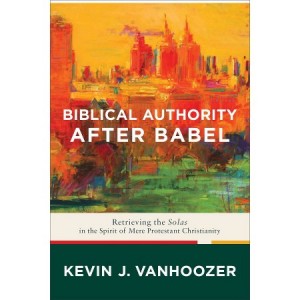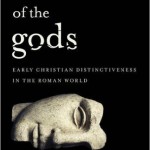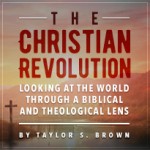I am still alive! Thanks to finals and road-tripping from Kentucky to Oklahoma, I haven’t been able to post anything since last Monday. But I’m back now and am hitting the ground running.
I’ve just started reading Kevin Vanhoozer’s recent book, Biblical Authority After Babel: Retrieving the Solas in the Spirit of Mere Protestant Christianity (Brazos, 2016). I’ve only read through the introduction so far, but Vanhoozer has already put forward some fascinating analysis and proposals.

The overall purpose of the book is to argue for a theological retrieval of what Vanhoozer calls “mere Protestant Christianity.” This framework is one encapsulated by the five solas of the Reformation: sola scriptura (Scripture alone), sola fide (faith alone), sola gratia (grace alone), solus Christus (Christ alone), soli Deo Gloria (glory to God alone). This encapsulation is meant to allow for an overarching theological unity within diversity. As Vanhoozer states it:
…I make so bold as to suggest that the solas, taken together, represent what we might call the first theology of mere Protestant Christianity. The solas are not isolated doctrines; they are theological insights into the ontology, epistemology, and teleology of the gospel. The solas are not a substitute for creedal orthodoxy but its servants. The solas do not develop the doctrine of the Trinity but presuppose it. Indeed, their special function is to preserve the integrity of the triune economies of revelation and redemption. As such, they are guides to theological judgment that both generate and govern mere Protestant theology. They also provide resources with which to respond to the charge that the Reformation unintentionally loosed interpretive anarchy upon the world. (p. 28; emphasis in original)
In conjunction with this retrieval of the Reformation solas, Vanhoozer argues for a retrieval and re-emphasis of the key Protestant emphasis on the royal priesthood of all believers. Vanhoozer believes that a proper understanding of the royal priesthood of all believers can effectively reinstitute a pattern of ecclesial authority in the larger project of Protestant Christianity. Vanhoozer even states that this retrieval and re-emphasis takes on the weight of a virtual sixth sola:
I will therefore speak of the “royal priesthood of all believers” to signal my intent to retrieve not only the principle of authority (the Triune God speaking in the Scriptures) but also the pattern of authority, which is to say the pattern of interpretive authority, an economy that identifies Jesus Christ alone as king, but accords pride of interpretive place to his royal priesthood…to put it more provocatively: in retrieving the royal priesthood of all believers, I am pursuing what amounts to a virtual sixth sola: sola ecclesia (church alone). (p. 29)
In addition to these major emphases, Vanhoozer (quite rightly) states that a robust “mere Protestantism” must be teleologically oriented toward a broader, catholicity. This does not mean a monolithic unity, but rather a diversity-in-unity. Vanhoozer again:
Catholicity is the final principle of the Reformation insofar as it regulates the process of biblical interpretation and the end toward which it tends, not the monological institutional unity of Rome but a dialogical or “plural” unity. Catholicity is an “Ephesian moment”—Andrew Walls’s term for that quintessentially evangelical moment when churches take a step toward and even greater realization of the unity of the body Christ…Catholicity is not chaos, however. It is the standing challenge for the church to display its unity in Christ despite differences…Mere Protestant Christianity is catholic Christianity inflected by the Reformation. (pp. 30-31)
All of these combine within Vanhoozer’s proposed project to present a “mere Protestantism” that is rooted far more in creedal orthodoxy and catholic unity-in-diversity than what is often seen within American Evangelicalism’s often fragmented makeup. As Vanhoozer puts it
The kind of Protestantism that needs to live on is not the one that encourages individual autonomy or corporate pride but the one that encourages the church to hold fast to the gospel, and to one another. The only good Protestant is a catholic Protestant—one who learns from, and bears fruit for, the whole church. (p. 33)
I’m looking forward to working my way through Vanhoozer’s work and seeing how he constructs this retrieval project of a “mere Protestant Christianity.”












